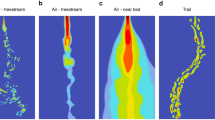Abstract
Free-flying drones (Apis mellifera) were attracted by pheromone to an elevated observation site where they looked for small distant objects, a visual task similar to nuptial pursuit. The brightness of the sky against which drones performed this task was measured as the radiance over a range of wavelengths covering the absorbance spectra of the principal drone rhodopsin and its metarhodopsin. This brightness varied relatively little, by just over one log unit. In laboratory experiments on the intact drone, the amplitude of photoreceptor responses to small decrements in intensity showed a marked maximum when the background intensity depolarized the cells to about −35mV. The radiance of this optimal background was only 0.2 log units greater than the sky radiance at which most drones were seen. It is argued that because of probable systematic errors the true difference may be less. It is known that in superfused retinal slices voltage-dependent sodium channels amplify small signals under these stimulus conditions. We therefore conclude that this amplification is useful for the major visual activity of the drone.
Similar content being viewed by others
References
Autrum H (1950) Die Belichtungspotentiale und das Sehen der Insekten (Untersuchungen an Calliphora und Dixippus). Z Vergl Physiol 32:176–227
Autrum H, Zwehl V von (1964) Die spektrale Empfindlichkeit einzelner Sehzellen des Bienenauges. Z Vergl Physiol 48:357–384
Baumann F (1968) Slow and spike potentials recorded from retinula cells of the honeybee drone in response to light. J Gen Physol 52:855–875
Baumann F (1974) Electrophysiological properties of the honeybee retina. In: Horridge GA (ed) The compound eye and vision in insects. Clarendon Press, Oxford, pp 53–74
Bertrand D, Fuortes G, Muri R (1979) Pigment transformation and electrical responses in retinula cells of drone, Apis mellifera ♂. J Physiol (Lond) 296:431–441
Buchanan JT, Moore LE, Hill R, Wallen P, Grillner S (1992) Synaptic potentials and transfer functions of lamprey spinal neurons. Biol Cybern 67:123–131
Coles JA, Schneider-Picard G (1989a) Amplification of small signals by voltage-gated sodium channels in drone photoreceptors. J Comp Physiol A 165:109–118
Coles JA, Schneider-Picard G (1989b) Increase in glial intracellular K+ in drone retina caused by photostimulation but not mediated by an increase in extracellular K+. Glia 2:213–222
Coles JA, Vallet AM (1991) Signal-to-noise ratio at high light intensities in drone photoreceptors. Neurosci Res Suppl 15:S1-S11
Currie RW (1987) The biology and behaviour of drones. Bee World 68:129–143
de Sousa J, Ventura DF (1989) Comparative study of temporal summation and response form in hymenopteran photoreceptors. J Comp Physiol A 165:237–245
Edrich W (1991) Ein erstaunliches Reaktionsvermögen von Drohnen auf visuelle Bewegungsreize. Verh Dtsch Zool Ges 84:341
Howard J, Snyder AW (1983) Transduction as a limitation on compound eye function and design. Proc R Soc Lond B 217:287–307
Howard J, Dubs A, Payne R (1984) The dynamics of phototransduction in insects: a comparative study. J Comp Physiol A 154:707–718
Huber F (1792) Nouvelles observations sur les abeilles adressees a M. Charles Bonnet. Barde, Mangel et Cie, Geneve
Jones GJ, Tsacopoulos M (1987) The response to monochromatic light flashes of the oxygen consumption of honeybee drone photoreceptors. J Gen Physiol 89:791–813
Laughlin SB, Weckström M (1993) Fast and slow photoreceptors — a comparative study of functional diversity of coding and conductances in the Diptera. J Comp Physiol A 172:593–609
Menzel JG, Wunderer H, Stavenga DG (1991) Functional morphology of the divided compound eye of the honeybee drone (Apis mellifera). Tissue and Cell 23:525–535
Muri R, Jones G (1983) Microspectrophotometry of single rhabdoms in the retina of the honeybee drone Apis mellifera ♂. J Gen Physiol 82:469–496
Praagh JP van, Ribi W, Wehrhahn C, Wittmann D (1980) Drones fixate the queen with the dorsal frontal part of their compound eyes. J Comp Physiol 136:263–266
Seidl R (1982) Die Sehfelder und Ommatidiendivergenzwinkel von Arbeiterin, Königin und Drohne der Honigbiene Apis mellifera. Thesis D17, Technische Hochschule Darmstadt
Stavenga DG (1992) Eye regionalization and spectral tuning of retinal pigments in insects. Trends Neurosci 15:213–218
Traub RD, Llinas R (1979) Hippocampal pyramidal cells: significance of dendritic ionic conductances for neuronal function and epileptogenesis. J Neurophysiol 42:476–496
Vallet AM (1992) Comportement visuel du mâle d'abeille et électrophysiologie des cellules photoréceptrices. Thesis, University of Bordeaux
Vallet AM, Coles JA (1993) The perception of small objects by the drone honey bee. J Comp Physiol A 172:183–188
Vallet AM, Coles JA, Eilbeck JC, Scott AC (1992) Membrane conductances involved in amplification of small signals by sodium channels in photoreceptors of drone honey bee. J Physiol (Lond) 456:303–324
Walz B (1992) Enhancement of sensitivity in photoreceptors of the honeybee drone by light and by Ca2+. J Comp Physiol A 170:605–613
Witherell PC (1971) Duration of flight and interflight time of drone honeybee, Apis mellifera. Ann Entomol Soc Am 64:609–612
Yoshii K, Moore LE, Christensen BN (1988) Effects of subthreshold voltage-dependent conductances on the transfer function of branched excitable cells and the conduction of synaptic potentials. J Neurophysiol 59:706–716
Author information
Authors and Affiliations
Rights and permissions
About this article
Cite this article
Vallet, A.M., Coles, J.A. Is the membrane voltage amplifier of drone photoreceptors useful at physiological light intensities?. J Comp Physiol A 173, 163–168 (1993). https://doi.org/10.1007/BF00192975
Accepted:
Issue Date:
DOI: https://doi.org/10.1007/BF00192975




